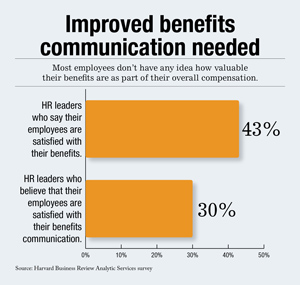 Estimates show that benefits, such as health insurance, paid time off, pension plans and disability insurance, make up approximately 30 percent to 40 percent of an employee’s total compensation package. However, according to the Society for Human Resource Management, employees have little, if any, understanding as to the value of their benefits as part of overall compensation.
Estimates show that benefits, such as health insurance, paid time off, pension plans and disability insurance, make up approximately 30 percent to 40 percent of an employee’s total compensation package. However, according to the Society for Human Resource Management, employees have little, if any, understanding as to the value of their benefits as part of overall compensation.
Benefits are considered the “hidden paycheck” of compensation. Unlike salary, which can be put into a bank or spent, benefits don’t provide liquidity. They are, however, important nonetheless.
"A solid benefits package is a plus—but only if employees know and understand what their employer makes available to them," Marianne Adams, assistant vice president of enrollment services at Colonial Life & Accident Insurance Co. told SHRM.
Then what’s an employer to do to communicate this type of information to employees? "Benefits statements are helping many employers today get greater value from the benefits they provide," Adams said.
A benefits statement provides employees with information about their total compensation such as health coverage, vacation time, parking, wellness center memberships and just about everything else. SHRM pointed out that another positive to benefits statements is they also offer information as when the employer is footing part – or all – of the benefits’ costs.
Such a statement doesn’t need to be complicated – even a list showing benefits, along with the costs and employer pay-in can go a long way toward educating employees that there is more to their compensation than the paycheck they receive.
This information can be enormously valuable to employees as they weigh their career and compensation options. After seeing benefits statements, employees might understand that, for example, not worrying about paying higher premiums for health coverage or having free parking is worth receiving a little less in a paycheck.
Meanwhile, on the employer side, benefits statements provide a good communication tool between management and workers.
"Employers find benefits statements tremendously valuable in helping their employees better understand and appreciate everything they provide," Adams commented. "We strongly encourage companies to take advantage of benefits statements to help with the increasingly important task of benefits education and communication."
© 2025 ALM Global, LLC, All Rights Reserved. Request academic re-use from www.copyright.com. All other uses, submit a request to [email protected]. For more information visit Asset & Logo Licensing.







